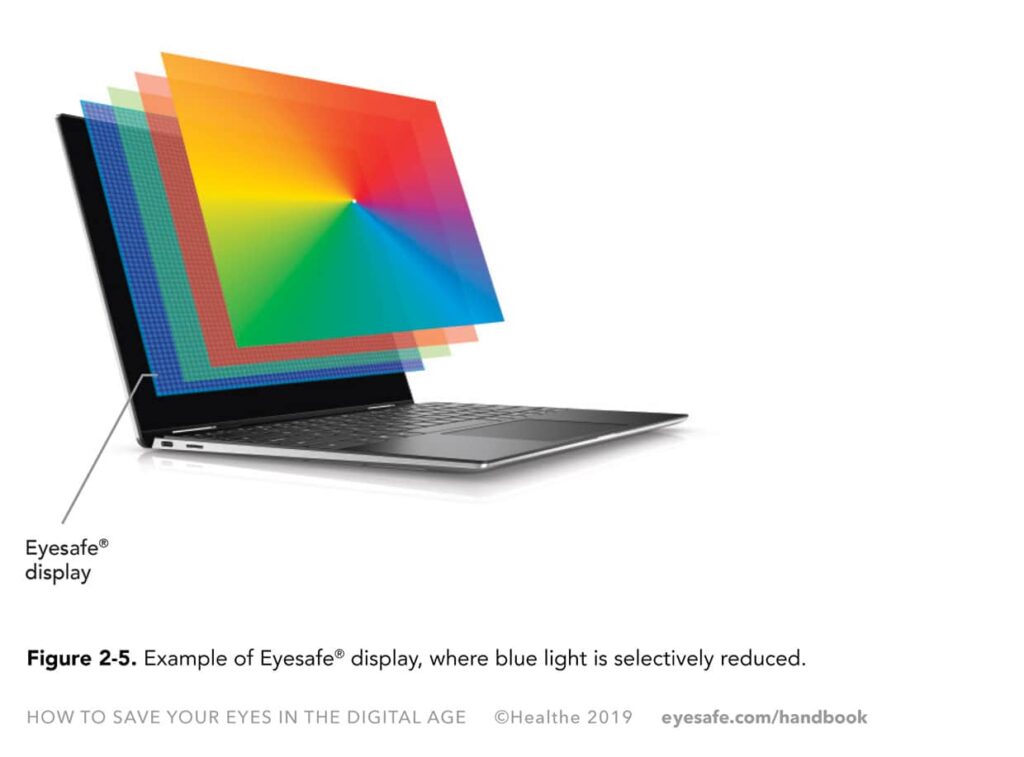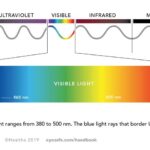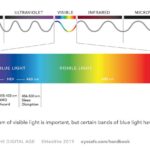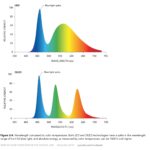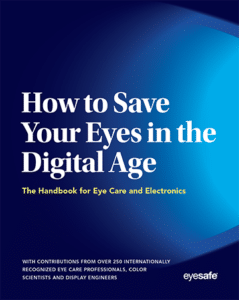How to Save Your Eyes in the Digital Age
The Handbook for Eye Care and Electronics
WITH CONTRIBUTIONS FROM OVER 250 INTERNATIONALLY RECOGNIZED EYE CARE PROFESSIONALS, COLOR SCIENTISTS AND DISPLAY ENGINEERS
SECTION 1: HOW BLUE LIGHT AFFECTS THE EYE AND BODY / CHAPTER 2
Blue Light and Displays
Although the dangers of UV rays from the sun have been known for years, we are only now recognizing that visible blue light from digital screens (and sunlight) also may pose risks to the health of our eyes.
What is Light?
Throughout the day, our eyes are nearly constantly exposed to light. Yet most of us would struggle explaining exactly what “light” is. Visible light is a very limited portion of the spectrum of natural and artificial electromagnetic radiation that includes gamma rays, X-rays, ultraviolet (UV) radiation, infrared rays, microwaves and radio waves.
Visible light is the only type of electromagnetic radiation that can be perceived by the human eye. All other types of electromagnetic rays are invisible.
Light and all other forms of electromagnetic radiation travel in waves. The length of these waves (“wavelength”) is inversely proportional to the energy of the radiation.
In other words, electromagnetic radiation that has very short wavelengths has very high energy, and rays with longer wavelengths have less energy.
The energy in light and other forms of electromagnetic radiation is contained within photons, which are a type of elementary particle. Photons carry a discrete quantity of energy (that’s proportional to the frequency of the waves) but have no mass.
Visible light has wavelengths ranging from 380 to 780 nanometers (nm). Portions of the electromagnetic spectrum are shown in Figure 2-1, in order from highest energy (shortest wavelengths) to lowest energy (longest wavelengths).
Each wavelength of visible light has a specific color.
Sunlight comprises a wide array of colors, whose intensities vary throughout the day. Blue light rays are stronger in the morning and at midday, promoting alertness. Later in the day and at dusk, blue light is less prominent, promoting relaxation.
Sunlight is the basis of life on earth, but too much exposure can cause damage to our skin and eyes. You can irreparably damage your eyes if you stare directly at the midday sun for even less than a minute. You can also prematurely age your eyes and skin through prolonged exposure.
Nonetheless, our physiology is better adapted to natural light than to blue-enriched artificial lighting. Health problems from overexposure to natural light are well understood. We are just beginning to understand the potential harmful effects of artificial blue light.
Blue Light
Blue light is a component of the visible light spectrum (Figure 2-2). In general, about 25% of sunlight is blue light. But the actual amount of blue light depends on many factors — including time of day, the season, and the latitude of your location.
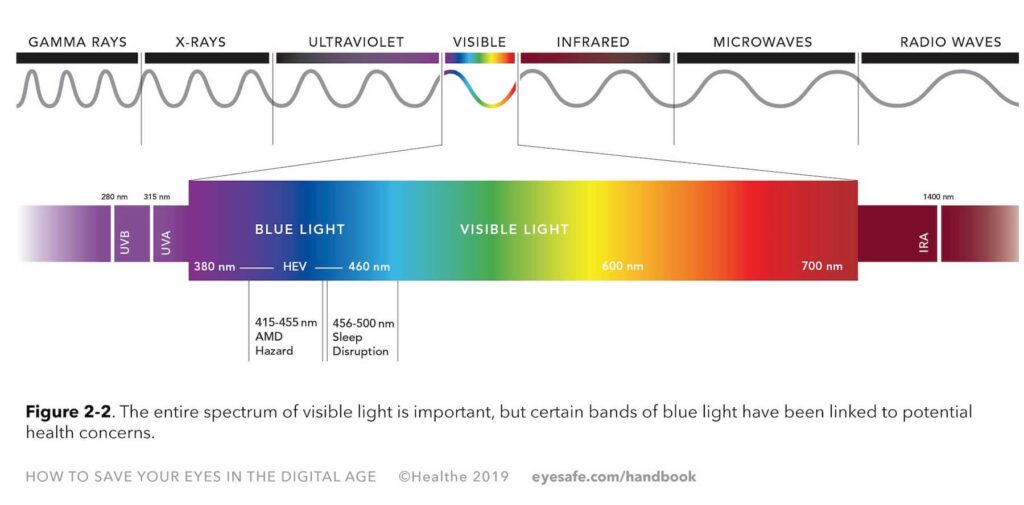
The blue-colored bands of visible light range in wavelength from 380 to 500 nm. Blue light also is known as high-energy visible (HEV) light because it has the shortest wavelengths — and therefore the highest energy — of all visible light.
Because too much HEV light can have negative effects, we have evolved ways to limit how much visible light enters our eyes. These adaptations include pupil constriction, reflexively looking away from the sun, and squinting in bright sunlight.
But these evolutionary adaptations don’t do us much good when we’re staring at the screens of our computers, tablets and phones for hours at a time and most of our day.
Researchers have found that high-energy blue light – particularly in the 415 to 455 nm wavelength range – produces oxidative and phototoxic damage to cells in the cornea and retina of the eye.1
Longer-wavelength blue light, on the other hand, has not been shown to be harmful to the eye. In fact, it helps regulate our wake/sleep cycle (circadian rhythm) and appears to contribute to physical and emotional health.
For this reason, the blue light spectrum sometimes is broken down into these functional categories:
- Harmful blue light: 400 to 455 nm
- Healthy blue light: 455 to 495 nm
Just below the blue light band are ultraviolet (UV) rays, which have higher energy than visible light. Lower-energy UVA rays (315 to 380 nm) account for approximately 95% of the ultraviolet radiation our bodies are exposed to. The balance are higher-energy UVB rays (280 to 315 nm) that have been associated with causing skin cancer.2
UVA penetrates into the deeper layers of the skin. In addition to producing a suntan, it causes premature aging of the skin and wrinkles. In moderation, UV exposure is beneficial. It helps the body produce vitamin D.
All UV rays are invisible and penetrate clouds. For this reason, sunglasses that block 100% of UV radiation should be worn outdoors in daylight – even on overcast days.
UV rays have been associated with eye conditions, including growths on the surface of the eye (pingueculae and pterygia), photokeratitis (snow blindness), cancers of the eye and eyelids, and cataracts.
Evolution of Artificial Light
The human eye evolved to harness sunlight. Fire and candlelight might seem quaint and romantic now, but for our ancestors these were the only source of light after sunset.
Incandescent lamps were invented in 1879, but they weren’t widely used until after World War I. With the establishment of electrical utilities, power standards and grids, millions of people could finally snuff out candles and switch on a light.
Fluorescent lighting became available in 1937. It was widely adopted in commercial and industrial settings because of its ability to provide near-daylight illumination.
Over the last 25 years, we have seen regulations and market forces favoring light sources that consume less energy. When compared with the common household incandescent bulb, compact fluorescent lamps (CFLs) provide better energy savings, longer life and are designed to fit existing appliances. Up until very recently, they were the most common source of commercial and household light.
LED (Light Emitting Diode) lights were first developed in 1962 at General Electric. As LED designs became better and better, they found use as low-power alternatives to incandescent and fluorescent lights. They have many advantages, including compact size, higher switching rates, better lighting efficiency (less heat as a byproduct) for wattage consumed, and can be designed into arrays for display screens.
You could say that LED lights have nearly eclipsed the sun in their usefulness in modern life. LEDs can effectively mimic virtually all colors of natural light, and they can be used 24 hours a day at relatively low cost compared with other sources of artificial light.
And, with new OLEDs (organic LEDs) finding commercial applications, we will be soon be seeing flexible displays that can be folded or even rolled up.
Computer, Cell Phone and TV Displays
Since the early days of television and computing, monitors and displays were powered by the cathode ray tube (CRT). A CRT display contains an electron gun (or 3 guns for color) and an electromagnet that directs an electron beam in a pattern to excite a phosphor field on the back side of the display glass.
CRTs worked fine for rendering the black and white and color images of the day, but they had size and form-factor limitations, high voltage requirements, relatively short lifecycles, and included toxic components.
In less than 20 years, LEDs and liquid crystal displays (LCDs) replaced CRTs in commercial display technologies. The last known manufacturer of CRTs stopped making them in 2015. You have to pay someone to dispose of a CRT tube nowadays. They are considered hazardous waste. And LCD displays, including handheld readers, are now most often illuminated with LED backlighting.
It’s been estimated that 90% of all artificial light will be produced by LED or OLED technology in the very near future.3 LEDs have advanced to meet the requirements of displays in smart devices, computers and wall-sized TV sets, and they serve the needs of an interconnected, always-on global society.
If all light sources were the same, this would be a wonderful and amazing story of advancement for society. But light sources are not the same.
The Blue Light Spike
If you compare the spectral emissions of light from sunlight and incandescent, fluorescent and LED sources, you will notice some clear differences. See Figure 2-3.
A blue LED has a spike of luminescence in the blue light range. In order to produce color, it excites yellow phosphor, shifting some of its energy into other color bands.
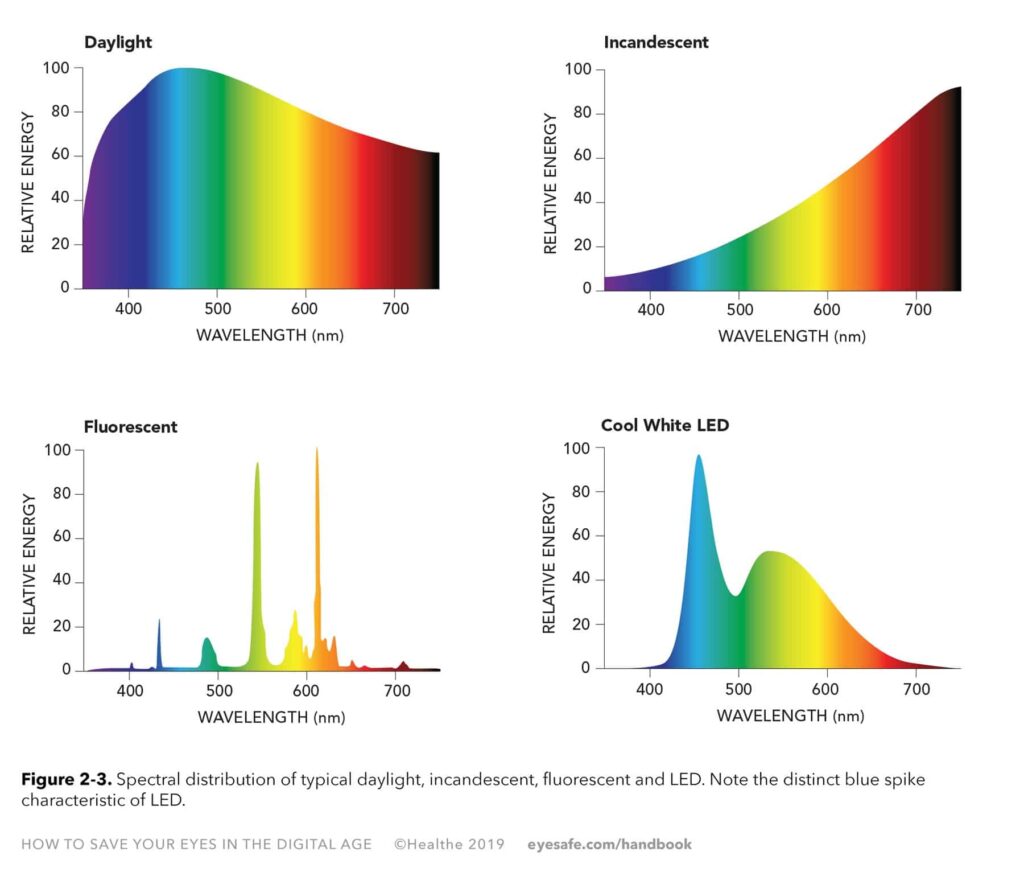
The International Dark Sky association reported concerns that LED lighting was disturbing the routines of nocturnal animals. A museum implicated LED lighting in the yellowing of pigments of precious oil portraits by Van Gogh and Cézanne.4
In May 2019, the French Agency for Food, Environmental and Occupational Health & Safety (ANSES) updated its 2010 assessment of the health effects of LEDs.5 After analyzing more than 600 recent research papers on the topic, ANSES confirmed its previous conclusion that blue light can have a toxic effect on the retina of the eye. The agency recommended measures to reduce blue light exposure, including:
- When choosing LED lighting for home use, select bulbs with a “warm white” tone (color temperature below 3000K). These LED lights emit less harmful blue light than “daylight” or “cool white” bulbs that have higher color temperatures.
- People (especially children) should reduce their exposure to the blue-rich light of LED screens (tablets, computers and smart phones) at nighttime to avoid disrupting biological rhythms and causing sleep problems that have been associated with multiple health conditions.
ANSES also called for the establishment of standards and performance criteria for devices and equipment designed to protect eyes from harmful blue light.
ANSES and other regulatory bodies are trying to raise the awareness that LEDs may be particularly harmful to certain risk groups that include infants and young children, people who lack a crystalline lens or have an artificial intraocular lens (IOL) following cataract surgery, pregnant women (due to possible dangers of disruption of the mother’s circadian rhythm to her unborn child), elderly people (glare effects), night workers exposed to LED lighting, people with sleep disorders, and anyone who suffers from migraine headaches.
One way to compare LEDs and OLEDs with other light sources is by color temperature, measured in degrees Kelvin (K). Normal daylight temperature averages 6500 K. White light bulbs range in color temperature from 2700 K for a warm hue to 7500 K for a bright cool hue. (See Figure 2-4.)
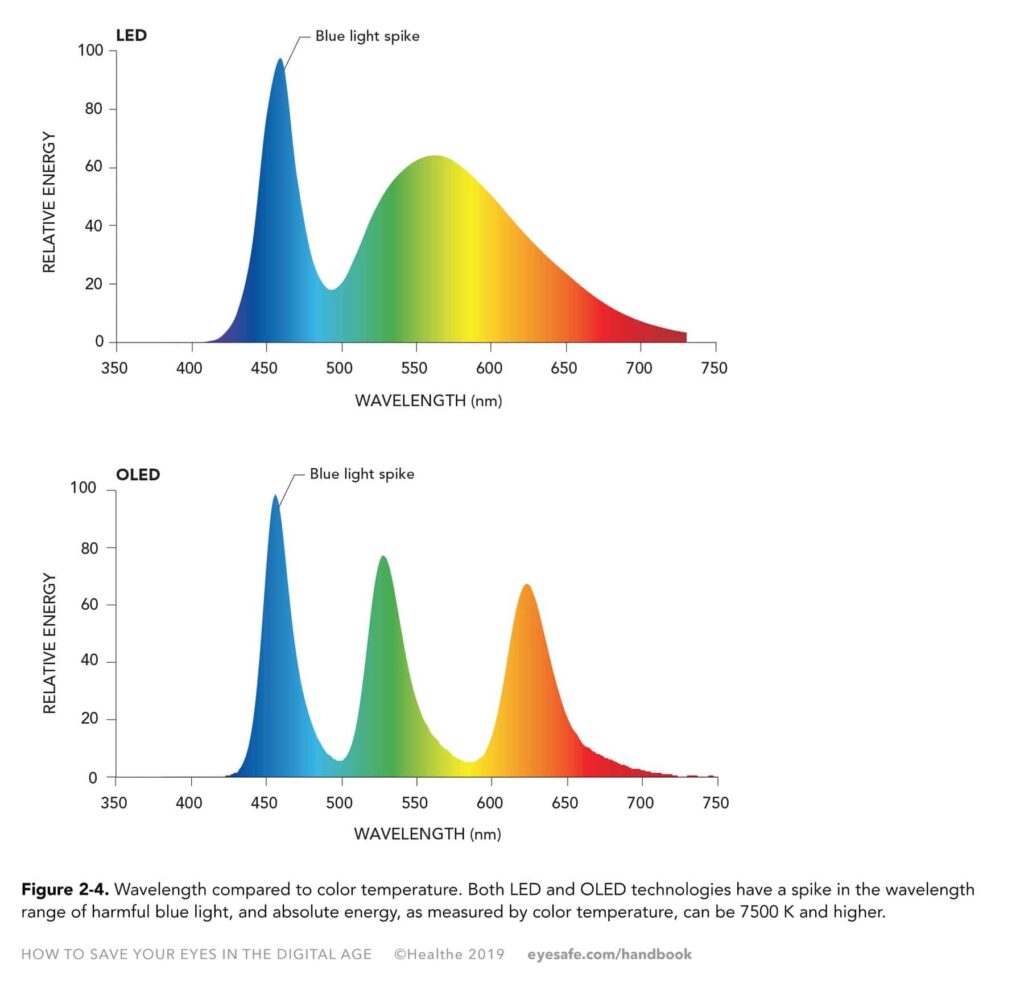
1. LED light bulbs today are steadily increasing in luminance per watt, and therefore creating intense bright light from very small sources.
2. Electronic displays (computers, cell phones, etc.) also are increasing in luminance, with high performance displays now operating at color temperatures of 7500 K and higher.
The blue light spike represents a challenge for display makers. Display makers mine the energy from the HEV band to power phosphors in other color bands so that a matrix of pixels can emulate practically any hue in the visible light band.
Very sophisticated methods are used today for creating artificial white light or enhancing color to make it pleasing to the eye. Display makers create LED and OLED displays that can render full color by altering phosphors that can precisely blend red, green and blue to very accurate levels.
The fact remains, however, that the blue light spike is a characteristic of displays, resulting in greater blue light exposure.
There are remedies to minimizing the blue light spike. Most of these solutions, however, either do not address it at the source, or they filter out too much blue light, making images appear dull and yellowish.
One remedy, as shown in Figure 2-5, is to apply an Eyesafe® blue light filter. The Eyesafe® filter selectively filters the characteristic blue light spike. This has minimal effect on color rendition and luminescence, enhancing eye comfort and retaining the integrity of the display experience.
Key Points on Blue Light
In summary, here are a few key points about blue light:
- Blue light has the shortest wavelengths and highest energy of all visible light.
- Like UV radiation, HEV blue light has beneficial and harmful effects.
- Blue light is everywhere – it’s present in both natural and artificial light.
- Our eyes naturally block most UV rays from reaching the retina, but they don’t block blue light.
- Not all blue light is bad. Longer-wavelength blue light helps regulate our sleep cycle.
- LEDs & OLEDs have a characteristic blue light spike.
- Displays can have a color temperature greater than sunlight.
- The lens of a child’s eye does not filter blue light as effectively as the lens of an adult eye, putting children at higher risk of eye damage from blue light exposure.
Gary Heiting, OD is Director of Vision Research at Eyesafe®. He received his Doctor of Optometry (OD) degree from Southern California College of Optometry in Fullerton, California. Dr. Heiting has more than 30 years of experience as an eye care provider, health writer and editor, and consultant to vision care companies.
CHAPTER 2 IMAGE GALLERY
What is blue light?
Researchers have found that high-energy blue light – particularly in the 415 to 455 nm wavelength range – produces oxidative and phototoxic damage to cells in the cornea and retina of the eye.1
Risk Groups:
The French agency ANSES5 and other regulatory bodies are trying to raise the awareness that LEDs may be harmful to:
• Infants and young children
• Post-cataract surgery patients
• Pregnant women
• Elderly people
• Night workers exposed to LED lighting
• People with sleep disorders
• Migraine sufferers
References
- Research progress about the effect and prevention of blue light on eyes, by Zhi-Chun Zhao, Ying Zhou, Gang Tan, Juan Li, Int J Ophthalmol, Vol. 11, No. 12, Dec. 18, 2018.
- UV radiation. World Health Organization. Accessed April 29, 2019.
- Light Emitting Diodes (LEDs) and the blue light risk, Points de Vue,
- Blue Light Hazards and Methods of Quantification, by Jwo-Huie Jou, Deepak Kumar Dubey, Sujith Sudheendran Swayamprabhaa, National Tsing Hua University Taiwan, SID 2019.
- Effects on human health and the environment of systems using LEDs, ANSES Press release 2019.
- What is electromagnetic radiation? Live Science, March 12, 2015.
- Violet light exposure can be a preventive strategy against myopia progression, EBioMedicine, February 2017.
- Photocytotoxicity of lipofuscin in human retinal pigment epithelial cells, by S Davies, MH Elliott, E Floor et al., Free Radical Biology and Medicine, 2001.
- The lipofuscin fluorophore A2E mediates blue light-induced damage to retinal pigmented epithelial cells, by JR Sparrow, K Nakanishi, CA Parish, Investigative Ophthalmology & Visual Science, 2000.
- Lipofuscin accumulation in cultured retinal pigment epithelial cells causes enhanced sensitivity to blue light irradiation, by U Wihlmark, A Wrigstad, K Roberg et al., Free Radical Biology and Medicine, 1997.
Get the EBook:
Download the digital edition of HOW TO SAVE YOUR EYES IN THE DIGITAL AGE: The Handbook for Eye Care and Electronics, and learn more.

